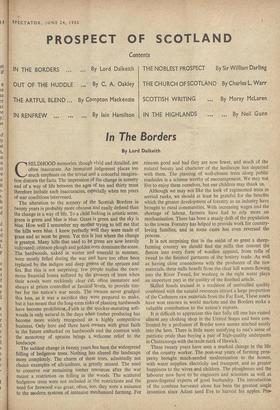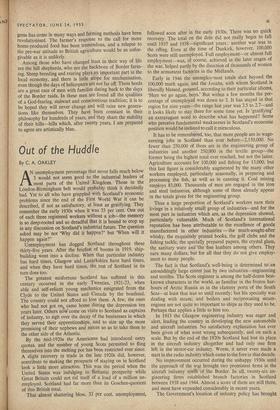In The Borders
By Lord Dalkeith
CHILDHOOD memories, though vivid and detailed, are often inaccurate. An immature judgement places too much emphasis on the trivial and a colourful imagina-. tion distorts the facts. The impression of the change in scenery and of a way of life between the ages of ten and thirty must therefore include such inaccuracies, especially when ten years of war conditions 'intervened.
The alteration to the scenery of the Scottish Borders in twenty years is probably more obvious and easily defined than the change in a way of life. To a child lacking in artistic sense, green is green and blue is blue. Grass is green and the sky is blue. How well I remember my mother trying to tell me that the hills were blue. I knew perfectly well they were made of grass and so must be green. Yet this is just where the change is greatest. Many hills that used to be green are now heavily cultivated; crimson plough and golden corn dominate the scene. The hardwoods, naked in winter and emerald in summer, were mostly felled during the war and have too often been replaced by the indigos and deep greens of the spruces and firs. But this is not surprising; few people realise the enor- mous financial losses suffered by the growers of trees when their woods were recklessly clear cut, often immature and always at prices controlled at farcical levels, to provide tim- ber for the nation's war needs. The owners never grudged this loss, as it was a sacrifice they were prepared to make, but it has meant that the long-term risks of planting hardwoods , have become prohibitive—Faith in the quicker-maturing soft- woods is only natural in the days when timber producing has become more widely recognised as a highly competitive business. Only here and there have owners with great faith in the future embarked on hardwoods and the contrast with the monotony of spruces brings a welcome relief to the landscape. The saddest change in twenty years has been the widespread felling of hedgerow trees. Nothing has altered the landscape more completely. The charm of these trees, admittedly not choice examples of silviculture, is greatly missed. The need to conserve our remaining timber resources after the war meant a restriction on felling in the woods. The scattered hedgerow trees were not included in the restrictions and the need for firewood was great; often, too, they were a nuisance to the modern systems of intensive mechanised farming. For reasons good and bad they are now fewer, and much of the natural beauty and character of the landscape has departed with them. The planting of well-chosen trees along public roadsides is a scheme worthy of encouragement. We may not live to enjoy them ourselves, but our children may thank us.
Although we may not like the look of regimented trees in serried ranks, we should at least be grateful for the benefits which the greater development of forestry as an industry have brought to rural communities. With increasing wages and the shortage of labour, farmers have had to rely more on mechanisation. There has been a steady drift of the population to the towns. Forestry has helped to provide work for country- loving families, and in some cases has even reversed the process.
It is not surprising that in the midst of so great a sheep- farming country we should find the mills that convert the fleeces into every form of woollen apparel, from rolls of tweed to the finished garments of the hosiery trade. As well as having close connections with the producers of the raw . material's, these mills benefit from the clear hill waters flowing into the River Tweed, for washing in the right water plays an important part in the quality of the finished article.
Skilled hands trained in a tradition of unrivalled quality combined with the natural resources attract a large proportion of the Cashmere raw materials from the Far East, These assets have won renown in world markets and the Borders make a valuable contribution to the nation's exports.
It is difficult to appreciate this fact fully till one has visited almost any clothing shop in the United States and been con- fronted by a profusion of Border town names stitched neatly into the hem. There is little more satisfying to one's sense of patriotic pride than buying a pair of high-quality underpants in Chattanooga with the trade mark of Hawick.
These twenty years have seen a marked change in the life of the country worker. The post-war years of farming pros- perity brought much-needed modernisation to the homes, with water supplies, electricity and transport, and so greater happiness to the wives and children. The ploughman and the labourer now have to be engineers and scientists as well as green-fingered experts of good husbandry. The introduction of the combine harvester alone has been the greatest single invention since Adam used Eve to harvest his apples. Pro. gress has come in many ways and farming methods have been revolutionised. The farmer's response to the call for more home-produced food has been tremendous, and a relapse to the pre-war attitude to British agriculture would be as unfor- givable as it is unlikely.
Among those who have changed least in their way of life are the hill shepherds, who are the backbone of Border farm- ing. Sheep breeding and rearing plays an important part in the local economy, and there is little scope for mechanisation, even though the days of helicopters are not far off. These herds are a great race of men with families dating back to the days of the Border raids. In these men are found all the qualities of a God-fearing, stalwart and conscientious tradition; it is to be hoped they will never change and will raise new genera- tions like themselves. They have been constant in their philosophy for hundreds of years. and they share the stability of their hills—hills which, after twenty years, I am prepared to agree are artistically blue.


















































 Previous page
Previous page